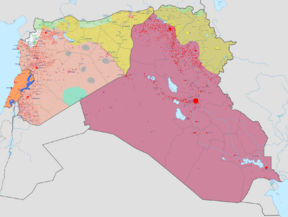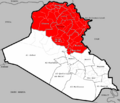War against the Islamic State facts for kids
Quick facts for kids War against the Islamic State |
|||||||
|---|---|---|---|---|---|---|---|
| Part of the war on terror, Second Libyan Civil War, War in Iraq (2013–2017), Syrian civil war and spillover of the Syrian civil war, Sinai insurgency, Boko Haram insurgency, insurgency in the North Caucasus, Moro conflict, Insurgency in Cabo Delgado, Qandala campaign and the Sahel War | |||||||
Map of the current military situation in Iraq, Syria, and Lebanon Map of the current military situation in Libya Map of the current military situation in Nigeria Map of the current military situation in Sinai Map of the current military situation in Yemen |
|||||||
|
|||||||
| Belligerents | |||||||
In multiple regions:
In Iraq: In Syria:
In Gaza: In Libya:
In Afghanistan: In West Africa:
|
|
||||||
| Commanders and leaders | |||||||
|
|
|
||||||
| Strength | |||||||
|
United States:
4,100 troops (in Iraq)
2,500 troops (in Kuwait) 7,000 contractors 500 soldiers to retrain the Iraqi army Australia:
400 RAAF personnel
200 special forces troops 300+ regular soldiers (combined with 100+ New Zealand soldiers) Canada:
Up to 200 special forces advisers
830 Canadian Armed Forces personnel Germany:
1200 troops
Italy:
130 search and rescue team
1,200 troops Russia:
4,000 personnel
Iran:
500 Quds Force members
1,500 Basijis Nigeria:
Army: 130,000 active frontline troops. 32,000 active reserve troops.
Police Force: 371,000 officers Cameroon:
20,000 soldiers
African Union:
8,700 soldiers
Syrian Salvation Government:
50,000+ soldiers
Islamic Front (2013-2015); 26,000-30,000 soldiers |
ISIL:
200,000 in Iraq and Syria (claim by Iraqi Kurdistan Chief of Staff)
28,600–31,600 in Iraq and Syria (Defense Department estimate) 35,000–100,000 (State Department estimate) 1,500+ in Egypt 6,500–10,000 in Libya 7,000–10,000 in Nigeria 1,000–3,000 in Afghanistan At least 400 in the Philippines and Malaysia Up to 600 tanks |
||||||
| Casualties and losses | |||||||
|
|
80,000+ militants killed overall |
||||||
|
13,568+ Iraqi civilians killed by Islamic State 8,317–13,190 civilians killed by Coalition airstrikes in Iraq and Syria (per Airwars) 4,096–6,085 civilians killed by Russian airstrikes in Syria 3,300,000 Iraqi civilians displaced |
|||||||
Many states began to intervene against the Islamic State, in both the Syrian Civil War and the War in Iraq (2013–2017), in response to its rapid territorial gains from its 2014 Northern Iraq offensives, universally condemned executions, human rights abuses and the fear of further spillovers of the Syrian Civil War. These efforts are called the war against the Islamic State, or the war against ISIS. In later years, there were also minor interventions by some states against IS-affiliated groups in Nigeria and Libya. All these efforts significantly degraded the Islamic State's capabilities by around 2019–2020. While moderate fighting continues in Syria, as of 2025, ISIS has been contained to a manageably small area and force capability.
In mid-June 2014, Iran, according to American and British information, started flying drones over Iraq, and, according to Reuters, Iranian soldiers were in Iraq fighting IS. Simultaneously, the United States ordered a small number of troops to Iraq and started flying crewed aircraft over Iraq. In July 2014, according to the International Institute for Strategic Studies, Iran sent Sukhoi Su-25 aircraft to Iraq, and Hezbollah purportedly sent trainers and advisers to Iraq in order to help Shia militias to monitor ISIL's movements. In August 2014, the US and Iran separately began a campaign of airstrikes on ISIL targets in Iraq. Since then, fourteen countries in a US-led coalition have also executed airstrikes on ISIL in Iraq and in Syria. Starting from September 2014, United States began closely co-operating with Saudi Arabia and Jordan to wage a co-ordinated aerial bombing campaign against IS targets across Iraq and Syria.
In September 2015, Russian forces launched its military intervention in Syria to support its ally Bashar al-Assad in the fight against the Islamic State. Although Moscow officially portrayed its intervention as an anti-IS campaign and publicly declared support to the "patriotic Syrian opposition", vast majority of its bombings were focused on destroying bases of the Syrian opposition militias of the Free Syrian Army (FSA) and Southern Front. On the other hand, United States and its Western allies have been opposed to the Ba'athist regime for its purported state-sponsorship of terrorism, violent repression of Syrian revolution and extensive use of chemical weapons. The US-led coalition trained, equipped and supported secular Free Syrian and Kurdish militias opposed to the Assad government during its anti-IS campaign. In the months following the beginning of both air campaigns, ISIL began to lose ground in both Iraq and Syria. Civilian deaths from airstrikes began to mount in 2015 and 2016. In mid-2016, the US and Russia planned to begin coordinating their airstrikes; however, this coordination did not materialize.
As of December 2017, ISIL was estimated to control no territory in Iraq, and 5% of Syrian territory, after prolonged actions. On 9 December 2017, Iraq declared victory in the fight against ISIL and stated that the War in Iraq was over. On 23 March 2019, ISIL was defeated territorially in Syria after losing the Battle of Baghuz Fawqani, after which the group was forced into an insurgency. ISIL's leader, Abu Bakr al-Baghdadi, died during a US special operations raid in northern Syria in October 2019 and was succeeded by Abu Ibrahim al-Hashimi al-Qurashi. The United Nations estimated in August 2020 that over 10,000 ISIL fighters remained in Syria and Iraq, mainly as sleeper cells.
Images for kids
-
U.S. soldiers from 1st Battalion, 6th Infantry Regiment near an oil facility in eastern Syria, 27 October 2020
-
A U.S. Green Beret demonstrates how to quickly fix a firearm malfunction to Revolutionary Commando Army fighters at al-Tanf garrison, 13 March 2020
-
U.S. Navy launching Tomahawk missiles from the Persian Gulf and the Red Sea against ISIL targets in Syria, 23 September 2014
-
Raqqa suffered extensive damage during the Battle of Raqqa
-
RAF Tornado GR4 over Iraq on an armed reconnaissance mission.
-
ISIL's territory, in grey, at the time of its greatest territorial extent in May 2015
-
Combined Air and Space Operations Center (CAOC) at Al Udeid Air Base, Qatar, provides command and control of air power throughout Iraq and Syria.
-
Combined Joint Task Force – Operation Inherent Resolve (CJTF–OIR) personnel pose for a picture during the Syrian intervention, 15 July 2021
See also
- 2003 invasion of Iraq
- Arab Winter
- Combined Joint Task Force – Operation Inherent Resolve
- Iraq War
- List of wars and battles involving ISIL
- Northern Iraq offensive (June 2014)
- Timeline of the Syrian Civil War (August 2014–present)























